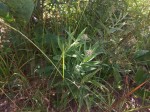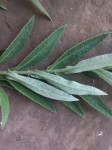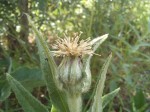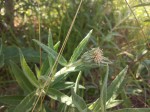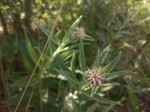Erythrocephalum scabrifolium
Selected images: Click on each image to see a larger version and details of the record View all images (5)
Detailed records: Display species records QDS maps by: Google Maps Point records by Google Maps
Species details: Click on each item to see an explanation of that item (Note: opens a new window)
| Synonyms: | |
| Common names: | |
| Frequency: | |
| Status: | Native |
| Description: |
An erect suffrutex to c. 60 cm tall, from a woody rootstock with numerous spreading, thong-like roots. Stems annual, 1-several, simple or branching above, leafy to the apex with leaves diminishing in size and number below, somewhat stem-sheathing on the lower stem, araneose-lanate sometimes becoming coarsely pilose-pubescent; the indumentum of fine matted-appressed whitish hairs sometimes intermixed with few to numerous large brownish patent hairs. Leaves discolorous, sessile, mostly 5–14 x 0.5–25 cm, linear-elliptic to narrowly oblong-lanceolate, attenuate acute to the apex, the lower part cuneate tapering to a semi-amplexicaul base, margins slightly revolute subentire; upper surface dark-green and sparsely araneose-lanate with appressed fine white hairs or sometimes these intermixed with stiff patent hairs and the indumentum scabridulous-araneose; lower surface densely greyish, sometimes brownish, araneose-lanate. Capitula 1–5, solitary and terminal on the stem and short apical branches, subtending leaf-like bracts wanting or small and ± equalling the capitula in length. Involucres mostly 11–15 x 10–20 mm, increasing to c. 25 mm wide when mature, becoming broadly campanulate and truncate at the base, araneose-lanate. Outer phyllaries 5–11 mm long, ovate or linear-lanceolate, acute or with a caudate appendage-like apical portion elongating to c. 20 mm long, fimbriate-denticulate on the margins especially in the upper part; inner phyllaries up to c. 16 mm long, tapering lorate, grading into the receptacular paleae, margins membranous often purplish and fimbriate-denticulate about the apex, the apex sometimes expanded and appendage-like. Ray-florets absent. Disk-floret corollas creamy-white, mostly c. 11 mm long, narrowly tubular below and abruptly dilated into a subcylindric-campanulate, deeply lobed limb c. 5 mm long, lobes c. 4 mm long, linear. Achenes c. 5 mm long, subcylindric, 5-angled, obscurely ribbed on the angles, minutely puberulous; carpopodium thin; pappus of caducous linear scale-like barbellate setae 6–8 mm long. Erythrocephalum albiflorum is easily confused with the similar E. scabrifolium but differs in the narrowly tapering to narrowly rounded semi-amplexicaul leaf bases; capitula without subtending and overtopping leaves or leaf-like bracts and the upper leaf surface seldom scabrid. |
| Type location: |
Zambia, Mpulungu |
| Notes: | |
| Derivation of specific name: | albiflorum: white-flowered. |
| Habitat: | |
| Altitude range: (metres) | |
| Flowering time: | Feb - Mar(-Apr) |
| Worldwide distribution: | Angola, DRC, Zambia and Malawi |
| FZ divisions: | N,S? |
| Growth form(s): | Perennial. |
| Endemic status: | |
| Red data list status: | |
| Insects associated with this species: | |
| Spot characters: | Display spot characters for this species |
| Literature: |
Pope, G.V. (1992). Compositae Flora Zambesiaca 6(1) Pages 24 - 25. Also as Erythrocephalum albiflorum Wild, H. (1972). The Compositae of the Flora Zambesiaca area. 3. Mutisieae. Kirkia 8(2) Page 177. Wild, H. (1972). New and Interesting Compositae from South Central Africa, 1 Kirkia 8(2) Pages 170 - 171. as Erythrocephalum albiflorum |
Other sources of information about Erythrocephalum scabrifolium:
Our websites:
Flora of Zambia: Erythrocephalum scabrifoliumExternal websites:
African Plants: A Photo Guide (Senckenberg): Erythrocephalum scabrifoliumAfrican Plant Database: Erythrocephalum scabrifolium
BHL (Biodiversity Heritage Library): Erythrocephalum scabrifolium
EOL (Encyclopedia of Life): Erythrocephalum scabrifolium
GBIF (Global Biodiversity Information Facility): Erythrocephalum scabrifolium
Google: Web - Images - Scholar
iNaturalist: Erythrocephalum scabrifolium
IPNI (International Plant Names Index): Erythrocephalum scabrifolium
JSTOR Plant Science: Erythrocephalum scabrifolium
Mansfeld World Database of Agricultural and Horticultural Crops: Erythrocephalum scabrifolium
Plants of the World Online: Erythrocephalum scabrifolium
Tropicos: Erythrocephalum scabrifolium
Wikipedia: Erythrocephalum scabrifolium
